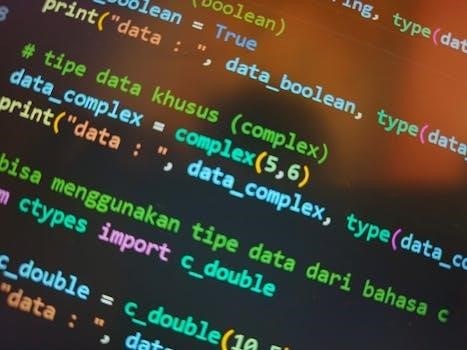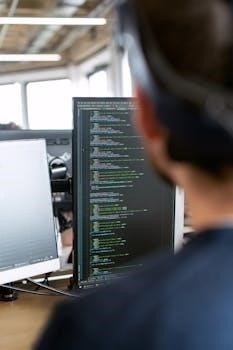Algorithmic trading, leveraging Python’s capabilities, is transforming finance by automating trades based on predefined strategies. This approach relies on computer programs to execute orders based on algorithms. It offers speed and efficiency, making it a powerful tool for market participants.
What is Algorithmic Trading?
Algorithmic trading, also known as automated trading or quantitive trading, involves using computer programs to execute trades based on a predefined set of instructions. These instructions, or algorithms, are designed to identify trading opportunities and automatically place orders without human intervention. It relies on mathematical and statistical analysis to develop trading strategies, which are then translated into code. The speed and efficiency of algorithmic trading allow for the execution of trades at optimal prices and times, minimizing human error and emotional biases. This approach is widely used in financial markets and has become a dominant force in modern trading.
Why Python for Algorithmic Trading?
Python has become the language of choice for algorithmic traders due to its versatility, vast libraries, and strong community support. It facilitates rapid development and deployment of trading systems.
Versatility and Popularity of Python
Python’s versatility and popularity in algorithmic trading stem from its ability to handle diverse tasks, from data analysis to strategy implementation. Its clear syntax and extensive libraries make it accessible to both beginners and experienced traders. Python enables users to automate every step of the trading process. It allows for monitoring price movements, placing orders, and setting stop-loss levels. The language has become a favorite among quantitative analysts and developers in the financial industry. This is because it provides a robust and flexible platform for creating sophisticated trading algorithms. Its adaptability to various trading strategies contributes to its widespread adoption.
Open-Source Nature and Community Support
The open-source nature of Python significantly contributes to its appeal in algorithmic trading, providing free access to resources and tools. This fosters collaboration and innovation within the trading community. Extensive community support ensures readily available solutions to coding problems and continuous development of new libraries. The language’s modular design and reusable components enable rapid prototyping and deployment of trading systems. This makes it an economical choice for traders. The vast online forums, tutorials, and documentation facilitate knowledge sharing and learning. This helps traders quickly adapt and improve their algorithmic strategies using Python.
Availability of Libraries and Resources
Python’s rich ecosystem of libraries and resources is a cornerstone of its popularity in algorithmic trading. Libraries like NumPy and Pandas are vital for numerical computation and data analysis, respectively, streamlining the development process. The availability of specialized packages for quantitative finance, such as Quantopian’s Zipline, further simplifies strategy implementation and backtesting. Online tutorials, documentation, and community forums offer extensive support for both beginners and advanced users. This abundance of resources allows traders to quickly learn, adapt, and implement sophisticated trading strategies, making Python a go-to language in the algorithmic trading domain. This easy access to quality knowledge is invaluable.
Essential Python Libraries for Algorithmic Trading
Several Python libraries are indispensable for algorithmic trading. NumPy facilitates numerical computations, while Pandas excels in data analysis. These tools enable efficient data manipulation and statistical analysis crucial for trading strategies.
NumPy for Numerical Computation
NumPy is a cornerstone library in Python for algorithmic trading, enabling efficient numerical computations essential for financial analysis. Its core strength lies in its ability to handle large arrays and matrices, facilitating swift processing of market data. With NumPy, traders can perform complex mathematical operations such as linear algebra, Fourier transforms, and random number generation.
This library’s optimized array operations are crucial for tasks like calculating moving averages, standard deviations, and correlations. NumPy’s performance enhancements are vital for high-frequency trading, where speed is paramount. By providing a robust foundation for quantitative analysis, NumPy empowers traders to develop and execute sophisticated strategies.
Pandas for Data Analysis
Pandas is an indispensable Python library for data analysis in algorithmic trading, offering powerful tools for data manipulation and exploration. It excels at handling structured data, particularly time series, making it ideal for financial datasets. Pandas introduces DataFrames, which provide a tabular structure with labeled rows and columns, simplifying data organization.
This library enables traders to clean, transform, and analyze financial data efficiently. With Pandas, users can easily perform tasks like data alignment, filtering, and aggregation. It also supports reading data from various sources, including CSV files and databases. Pandas plays a crucial role in preparing data for backtesting and strategy development.

Setting Up Your Python Environment
To begin algorithmic trading with Python, setting up your environment is crucial. This involves installing Python, package managers like pip, and necessary libraries such as NumPy and Pandas for data manipulation and analysis.
Installing Necessary Libraries
To kickstart your algorithmic trading journey with Python, installing the right libraries is essential. Use pip, Python’s package installer, to easily acquire these tools. Start with NumPy for numerical computations, enabling efficient array operations crucial for financial calculations. Next, install Pandas for data analysis, providing powerful data structures like DataFrames to handle time series data effectively.
Also, consider Matplotlib and Seaborn for data visualization, helping you understand market trends visually. For interacting with financial data sources, install libraries like yfinance to fetch historical stock data directly from Yahoo Finance. These libraries form the foundation for building and testing your trading strategies. Properly installing these tools ensures a smooth and productive algorithmic trading experience.

Data Acquisition and Handling
Data acquisition and handling are critical for algorithmic trading. Python simplifies fetching data from sources like Yahoo Finance. Effective data preparation and cleaning are also essential to ensure accurate and reliable trading strategies.
Acquiring Financial Data (e.g., from Yahoo Finance)
Acquiring financial data is the first step in algorithmic trading with Python. Libraries like `yfinance` simplify fetching historical stock prices, volume, and other relevant information from sources like Yahoo Finance. This data forms the foundation for analysis and strategy development. Reliable data is essential for making informed trading decisions. Accessing this information programmatically enables automation and efficiency in your trading process. Using Python, you can easily retrieve and manage vast amounts of financial data. This capability is vital for backtesting strategies and identifying potential trading opportunities. Accurate and timely data is a cornerstone of successful algorithmic trading.
Data Preparation and Cleaning
Data preparation and cleaning are crucial steps in the algorithmic trading workflow. Raw financial data often contains errors, missing values, or inconsistencies that can negatively impact trading strategies. Using libraries like Pandas, traders can handle missing data, remove outliers, and ensure data consistency. Cleaning data involves handling missing values, correcting errors, and ensuring data types are appropriate. Transforming data might include normalization or feature engineering to improve model performance. Proper data preparation ensures that the trading algorithm receives high-quality input, leading to more reliable and profitable trading decisions. Thorough cleaning and preparation are vital for accurate backtesting and live trading.

Developing a Simple Algorithmic Trading Strategy
Developing a strategy involves defining rules for buy/sell decisions using Python. This includes choosing indicators, setting parameters, and defining entry/exit points. This forms the core logic of the trading algorithm, driving automated actions.
Moving Average Crossover Strategy Example
A moving average crossover is a popular, simple algorithmic trading strategy. It involves calculating two moving averages of a stock’s price⁚ a short-term and a long-term average. A buy signal is generated when the short-term average crosses above the long-term average, indicating upward price momentum. Conversely, a sell signal occurs when the short-term average crosses below the long-term average, suggesting downward momentum. This strategy is easy to implement in Python using libraries like Pandas. Traders can adjust the periods of the moving averages to optimize performance. Backtesting is crucial to evaluate the strategy’s effectiveness.
Generating Trading Signals
Generating trading signals is a core component of algorithmic trading strategies. These signals trigger buy or sell orders based on predefined rules and conditions. In Python, this involves analyzing financial data, applying technical indicators, and defining thresholds for action. For example, a moving average crossover strategy generates signals when the short-term moving average crosses the long-term average. Other signals could be based on momentum oscillators like RSI or MACD. Precise coding ensures signals are accurately generated and acted upon. Careful backtesting refines signal parameters and improves strategy performance. The goal is to automate profitable trade execution.
Backtesting Your Strategy
Backtesting is crucial for evaluating your algorithmic trading strategy. It simulates trades on historical data to assess performance. This process helps identify potential weaknesses and optimize parameters before live deployment.
Simulating Trade Execution
Simulating trade execution is a vital component of backtesting any algorithmic trading strategy. This process involves replicating how trades would have unfolded in the past, given specific market conditions and trading signals generated by the algorithm. Accurate simulation requires handling order types, transaction costs, and market impact. By simulating trade execution, traders gain insights into realistic strategy performance. This enables them to adjust parameters and optimize their approach.
Furthermore, it helps identify potential issues like slippage or unexpected delays, ultimately improving the robustness and profitability of the trading system when deployed in live markets. This step provides a comprehensive understanding of the strategy’s behavior under varied conditions.
Advanced Techniques in Algorithmic Trading
Advanced techniques in algorithmic trading utilize machine learning and predictive analytics. These methods aim to identify complex patterns and forecast market movements. They involve sophisticated modeling and optimization strategies for improved performance.
Machine Learning for Trading
Machine learning is becoming increasingly vital in algorithmic trading. It enables the creation of adaptive trading strategies that learn from data. These strategies can automatically locate entry and exit points. Machine learning models are used to predict price movements, identify market trends, and manage portfolios.
Python, with libraries like Scikit-learn and TensorFlow, is perfect for implementing these models. Techniques such as regression, classification, and clustering are applied to financial data. This facilitates the development of more sophisticated and profitable trading algorithms by uncovering hidden patterns and relationships that traditional methods might miss, leading to enhanced decision-making in dynamic markets.

Popular Python Trading Platforms
Several Python trading platforms have emerged, catering to both beginners and experienced algorithmic traders. These platforms provide tools and APIs for building, testing, and deploying trading strategies. Quantopian is a well-known platform for research and backtesting. It offers a collaborative environment for developing algorithms.
Another popular choice is Zerodha’s Kite Connect API, which allows traders in Indian markets to automate their strategies. Other platforms include Interactive Brokers’ API, which provides access to global markets. These platforms offer various features such as real-time data, order management, and risk assessment tools, empowering traders to automate their trading processes effectively and efficiently.